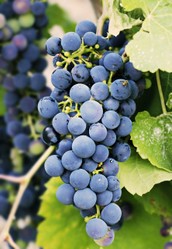I will work on an example, blackberry wine. You wlll need a demijohn [jar], fermentation lock, rubber bung with a hole for the lock and sodium sterilizing powder. Put a teaspoonful of the powder into the jr and wash it out with warm water. Make sure it is all washed out
Get a pound of blackberries and place them in a pan, bringing them gently to heat, but not to boiling. Soon you will have a dark liquid. Pour the liquid through a plastic funnel into the demjohn. Then pour two pounds of white sugar into the jar. When the temperature of the jar is about 25c you can add your yeast. Many wine makers make a yeast starter the day before brewing, which is a bottle containing yeast, yeast nutrient, sugar and warm water. The advantage of this is that it gets the fermentation off to a good start, but it is also possible to simply pour in the yeast and the yeast nutrient. Then top up the jar with warm water, but do not overfill. Part fill the fermentation lock with water, stick it into the hole in the rubber bung, then seal the jar. Your ferment will start, at first slowly with a few bubbles, then it will quicken.
Wine cannot be hurried. Leave your wine in a warm, dimly lit place, maybe for three weeks until the ferment is over. Then to make sure drop a sterilizing tablet into the jar. Quickly reseal, as you do not want germs entering. You can get wines that are ready in three weeks, so the kit manufacturers tell you, but if you want quality you must be prepared to wait for the wine to mature. Some winemakers wait for year.
Sometimes a wine will be cloudy. This is more the case with white wines. When this happens use wine finings, which is a substance that clears the cloudiness, depositing it at the bottom of the jar.
Occasionally in the days after starting your wine the ferment goes crazy and bubbles up into the fermentation lock. Don't worry over this, simply clean out the lock and replace the water. To avoid contamination some winemakers have a spare lock ready.
Winemakers rack their wines after fermentation is over. This involves siphoning off the wine into a clean demijohn. When doing this leave the cloudy bit at the bottom, it is waste. The new jar is sealed with a bung without a hole, as there should be no gas escaping. Then they wait a couple of weeks at least before siphoning off into bottles. Bottles should be corked rather than screw capped because if there is a residual ferment a screw-capped bottle could explode, whereas a cork just pops out. My mother told me a family story that one of her father's brothers once brewed beer, but bottled it before the ferment was complete. During the night the family heard a series of loud pops, and came downstairs to find the kitchen covered in beer froth.













 Pilgrimage. A reviewon 06/15/2025
Pilgrimage. A reviewon 06/15/2025
 Leo the Fourteenthon 05/09/2025
Leo the Fourteenthon 05/09/2025
 The Melsonby Hoardon 03/25/2025
The Melsonby Hoardon 03/25/2025



Comments
Possibly, but do not ,rely on my advice on cooking. For your health and safety.
Thank you for your comments below on Dec. 14, 2023, in answer to my previous-day observation and question.
Jar-bottom sediment ending as compost if one endeavors toward recycle-friendly efforts intrigues me.
Might it be possible to mix those dregs into bread and dessert dough for an interesting taste and texture?
With wine you can use a strainer bag, but it does not suffice to get the very finest sediments from the bottom of the jar. Wine makers have to accept that some wine from each batch will be wasted.
You siphon off as much wine as You can, accepting that some wine, the bit at the bottom of the jar, will wasted. Then pour out the dregs onto the compost heap or down the drain.
Thank you!
How do you get the sediment out without losing wine? With a hand-held sieve?
The sediment is undrinkable, but it could be put into a hot composted. I say hot because a cold compost might not kill any unwanted seeds.
Back in Feb. 21-22, 2022, we had a question-and-answer -- ;-D -- comment box regarding strawberry wine.
The north and the south yards typically have wild strawberries March through November.
You mentioned then, and again here, in the second paragraph to the first subheading, Personal experience, white-sediment deposits of sunken strawberry seeds and of yeast sediment.
Might that deposit be drinkable or scrapable for use somewhere else in some other way?
Thank you!
Black currants, blackberries and elderberries grow in the east-, north-, south-, west-lawn edges. You honor black currants in the comment box below and blackberries in the first paragraph under your subheading Personal Experience.
So that's a project for the next growing season.
I do not know of any such ingredient, but moderating elderberry, for example with blackcurrant, can produce a less tatty wine. Maybe it is the amount of elderberry that causes the problem rather than its presence.
The third-to-last sentence under the first subheading, Personal experience, cautions that "elderberry alone is quite tarty and some people can have a mild stomach pain with them."
Is there some additional ingredient or some alteration of the wine-making process that remedies tarty elderberry? Or must elderberries always be associated with tarty-ness?